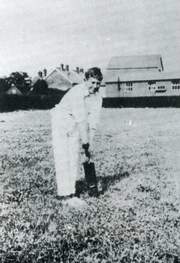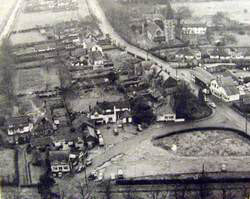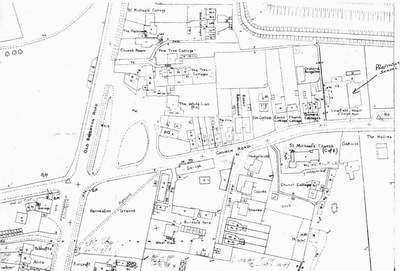Abandoned Communities ..... Lowfield Heath
There were two recreation grounds, one for adult sports behind Plumridge's coach garage on the west side of the A23, the other, known as Mason's recreation ground, on the south east corner of the crossroads in the centre of the village. It seem that the origin of the name of Mason's recreation ground was forgotten, but after it was sold in 1981 it was discovered that it had been given to the people of the village by Thomas Alexander Mason. Mason, a modest and private person, devoted much of his wealth to buying plots of land and allowing them to be used for recreational purposes by local people.
A resident of the village who features several times in Jean Shelley's book was Ralph Peters, otherwise known as Son Peters. Sadly his own recollections are not recorded, but we learn from others that he lived at 4 Side View during the Second World War and later moved to Church Road. He worked at Cheal's Nurseries, and after the opening of the British Legion club took a job as its Steward. He was a member of the village cricket team (you can see him in the picture on the previous page, standing next to the pipe smoking umpire), and enjoyed a game of darts (in a photograph on the left you can see him taking his turn to throw). According to his sister Dora Wallace he responded to the building of Gatwick airport by saying that the airport wasn't going to push him out of his home, he was going to stay put. He died in his 50s in 1971, three years before the last residents left the village. His sister later remarked “I often wonder what would have happened if he had lived, because he really meant it.”
The end of Lowfield Heath came as a result of the development of Gatwick airport. Land at Hunts Green, a farm a short distance north east of Lowfield Heath, started to be used as an aerodrome in the 1920s. A Mr Waters moved into Hunts Green early in 1930, and formed the Surrey Aero Club. Soon the farmhouse became the club house. Commercial flights started in 1933, and the renowned Beehive circular terminal was constructed in 1936. In 1950 the government decided that the second London airport should be located at Gatwick. The work needed to upgrade the airport was carried out between 1956 and 1958.
Wikipedia has a detailed history of the airport in its article on Gatwick Airport.
The village of Lowfield Heath lay immediately outside the airport on the southern side. The presence of the airport, apart from the noise and general inconvenience, meant that the village became more isolated. The A23 had to be diverted around the eastern end of the airport, the new stretch of road rejoining the old road south of Lowfield Heath.
The school was closed in 1956, and the village seems to have suffered a gradual decline until the last people moved out in 1974. The land was purchased and converted into several small trading estates, most of whose businesses served the airport.
One organisation that survived the ending of the village was the Lowfield Heath branch of the British Legion. The clubhouse on Charlwood Road continued to be used until July 2007. Since then the branch members have met in Crawley.
Percy Bish commented on the ending of Lowfield Heath in an article in the Crawley Observer on 9 April 1981. As a teenager he enjoyed watching the planes landing on the airfield and the balloons descending as they ran out of hot air, and he could recall a 20 minute trip in a biplane after the flying club was created. But now he missed the life of the village. After he had to move away he would return to watch the heavy machinery being brought in and everything being razed to the ground. “The whole community was split up and scattered.”
A resident of the village who features several times in Jean Shelley's book was Ralph Peters, otherwise known as Son Peters. Sadly his own recollections are not recorded, but we learn from others that he lived at 4 Side View during the Second World War and later moved to Church Road. He worked at Cheal's Nurseries, and after the opening of the British Legion club took a job as its Steward. He was a member of the village cricket team (you can see him in the picture on the previous page, standing next to the pipe smoking umpire), and enjoyed a game of darts (in a photograph on the left you can see him taking his turn to throw). According to his sister Dora Wallace he responded to the building of Gatwick airport by saying that the airport wasn't going to push him out of his home, he was going to stay put. He died in his 50s in 1971, three years before the last residents left the village. His sister later remarked “I often wonder what would have happened if he had lived, because he really meant it.”
The end of Lowfield Heath came as a result of the development of Gatwick airport. Land at Hunts Green, a farm a short distance north east of Lowfield Heath, started to be used as an aerodrome in the 1920s. A Mr Waters moved into Hunts Green early in 1930, and formed the Surrey Aero Club. Soon the farmhouse became the club house. Commercial flights started in 1933, and the renowned Beehive circular terminal was constructed in 1936. In 1950 the government decided that the second London airport should be located at Gatwick. The work needed to upgrade the airport was carried out between 1956 and 1958.
Wikipedia has a detailed history of the airport in its article on Gatwick Airport.
The village of Lowfield Heath lay immediately outside the airport on the southern side. The presence of the airport, apart from the noise and general inconvenience, meant that the village became more isolated. The A23 had to be diverted around the eastern end of the airport, the new stretch of road rejoining the old road south of Lowfield Heath.
The school was closed in 1956, and the village seems to have suffered a gradual decline until the last people moved out in 1974. The land was purchased and converted into several small trading estates, most of whose businesses served the airport.
One organisation that survived the ending of the village was the Lowfield Heath branch of the British Legion. The clubhouse on Charlwood Road continued to be used until July 2007. Since then the branch members have met in Crawley.
Percy Bish commented on the ending of Lowfield Heath in an article in the Crawley Observer on 9 April 1981. As a teenager he enjoyed watching the planes landing on the airfield and the balloons descending as they ran out of hot air, and he could recall a 20 minute trip in a biplane after the flying club was created. But now he missed the life of the village. After he had to move away he would return to watch the heavy machinery being brought in and everything being razed to the ground. “The whole community was split up and scattered.”
Four
Ralph Peters
Ralph Peters throwing during a darts match in the British Legion club.
Aerial view of Lowfield Heath from the west. This photograph was taken after the development of Gatwick airport and the diversion of the A23.
Lowfield Heath in 1965



